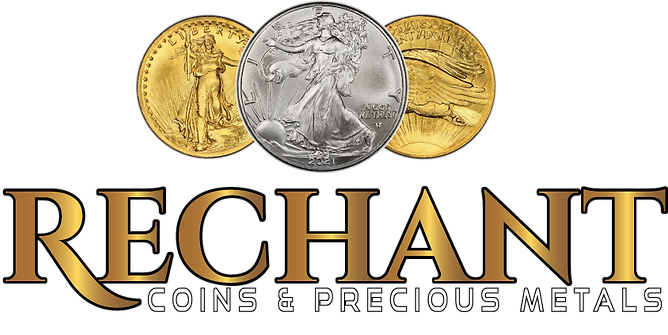Investing In Gold Bars Today
Gold bars remain one of the most effective ways to preserve wealth. By choosing to invest in physical gold, you shield yourself from the unpredictable nature of derivative markets.
Unlike other assets, gold bars retain intrinsic value, providing a stable hedge against inflation.
Investing in gold bullion is especially popular among those seeking to diversify their portfolios with tangible assets.
At Rechant Coins & Precious Metals, located in West Palm Beach and serving South Florida since 1975, we pride ourselves on offering competitive rates for gold bullion and rare coins.
Whether you're a seasoned investor or considering starting with gold bars, our team of experienced professionals ensures a seamless and informed experience. We provide guidance with no pressure to help you make the right decisions for your financial goals.
Visit our store and invest in gold with confidence.
Click here to learn more about: for sale now
Why Physical Gold is Special
- Market liquidity: Gold bullion is easy to buy, sell, and trade globally due to its universal value.
- Durability: Gold bars, made with high fineness, maintain their quality over decades.
- Insurance against risks: Unlike currencies, gold investments are not directly impacted by government policies or market crashes.
Whether you wish to purchase Canadian Gold Maple Leaf coins, American Eagles, or larger bars, Rechant Coins is your trusted source for securing high-quality, authentic bullion products.
The Benefits Of Gold As An Asset
Gold as an investment offers unique advantages that few other asset classes can match. It has served as a reliable store of value for centuries, even during turbulent economic periods. For instance, during the Great Depression, gold acted as a global reserve, stabilizing economies when traditional currencies depreciated in value. Gold’s universal appeal and scarcity ensure its role as a hedge against inflation and economic downturns.
Lessons from Gold's Historical Importance
In 1933, the U. S. government suspended the gold standard, but the demand for physical gold never waned, proving its enduring financial relevance.
Modern markets continue to emphasize the advantages of owning gold bullion. Unlike stocks or other paper-based assets, gold remains immune to sudden devaluations or liquidity crises. Investors typically add gold bars and coins to their portfolios to balance risks and ensure long-term wealth preservation.
Practical Benefits of Adding Gold
Here are some tangible ways gold investment enhances your financial resilience:
- Portfolio diversification: Gold serves as a counterbalance to traditional assets like stocks and bonds.
- Preservation of wealth: A fixed amount of gold retains purchasing power over time.
- Global demand: From jewelry to industrial use, demand for gold remains high globally.
At Rechant Coins & Precious Metals, we cater to gold buyers across South Florida, offering everything from coins to larger gold bars. Our inventory includes items like fractional gold pieces, minted bullion, and rare historical coins, ensuring all types of investors find what they’re looking for.
Invest in gold bars that meet your financial goals today. At Rechant, we help you navigate each step confidently while ensuring you acquire authentic, high-value precious metals. With over four decades of expertise, you can trust us to guide your gold-buying journey.
How to Diversify with Precious Metals
Precious metals offer a proven way to diversify your portfolio, giving investors stability and protection against economic uncertainty. Gold, silver, and platinum each present unique advantages when introduced into your financial strategy, whether it's using gold as a hedge against inflation, silver to capture industrial demand, or platinum for its rare industrial appeal.
By mixing these metals, you effectively mitigate risks and enhance long-term returns.
Keep reading to discover how to strategically allocate these assets and why gold bars remain a timeless investment.
How To Diversify With Precious Metals
Diversifying with precious metals helps ensure that your portfolio remains resilient during market fluctuations.
Gold, widely recognized for its historical reliability, acts as a hedge against inflation. This precious metal is also highly liquid, making it a go-to choice for many investors looking for an asset with enduring value.
If you buy gold, you’re purchasing both stability and long-term wealth preservation.
Silver, though often overshadowed by gold, is an attractive option due to its affordability and widespread industrial applications. The price of gold and silver can behave differently during times of economic stress.
Silver typically experiences higher volatility, which could offer opportunities for strategic investors.
Including silver in your mix allows you to take advantage of its growing industrial demand without overexposing your holdings to market risks.
Platinum, a lesser-utilized but valuable option, provides its own unique appeal.
Often regarded as a niche investment, this precious metal is significantly rarer than both gold and silver. It is used in various industrial sectors, from automotive to medical industries, giving it a demand profile distinct from other metals.
Its price often correlates inversely to gold, presenting a diversification benefit by offsetting gold’s trends during economic downturns.
A balanced allocation is key when considering a mix of these metals. Many experts recommend dedicating 60–70% of your precious metal holdings to investments in gold, 20–30% to silver, and 10–20% to platinum.
By striking a balance between these metals, you reduce overall portfolio risk while benefiting from their combined strengths.
“A well-diversified portfolio of gold, silver, and platinum provides both long-term stability and growth opportunities, ensuring wealth protection during economic uncertainty. ”
Exploring the Value of Gold Bars
Owning gold bars is one of the simplest and most effective ways to secure long-term wealth.
These bars offer a unique advantage due to their high purity, with many meeting the. 9999 standard for fine gold.
Compared to gold coins, bars often come with lower premiums, making them an economical choice for anyone looking to acquire physical gold in substantial amounts.
Why Gold Bars Are Significant
Gold bars are highly prized among investors for their tangible value and stability. The price of gold bars often makes them a better alternative when seeking to purchase larger quantities of gold at once.
Ranging in weight options—from one ounce to one kilogram—gold bars are easily customizable to fit various portfolio needs. Whether you’re a seasoned investor or new to the market, they provide a straightforward way to invest in physical gold.
Key Features of Gold Bars
Gold bars are known for their uniformity and quality.
Bars are meticulously crafted to ensure consistent weight and purity, with most adhering to stringent. 9999 fineness standards.
These characteristics make them highly liquid assets in global markets.
Gold bars often carry less intricate designs than coins, which helps minimize manufacturing costs and lowers premiums for investors looking to maximize gold content in their holdings.
Incorporating gold bars into a diversified portfolio not only stabilizes wealth but also provides a hedge against inflation and currency devaluation. Whether you purchase gold bars to hold over decades or for their appeal as an insurance asset in uncertain economic climates, they remain a reliable and practical investment choice.
“Gold bars serve as a cornerstone of any precious metal portfolio, offering tangible security and long-term preservation of wealth. ”
Diversifying with Precious Metals
- Gold acts as a hedge against inflation and is highly liquid, making it a reliable choice for wealth preservation.
- Silver offers affordability and benefits from growing industrial demand, providing opportunities during economic stress.
- Platinum, being rarer than gold and silver, has unique industrial uses and often correlates inversely to gold prices.
- A balanced allocation of 60–70% gold, 20–30% silver, and 10–20% platinum reduces portfolio risk and enhances stability.
A Guide to Safely Buying Gold and Monitoring Gold Market Trends
Investing in gold can be a reliable way to enhance your financial portfolio, but taking the right precautions is crucial for success. In this guide, we’ll provide essential tips to help you buy gold securely and ensure you're informed about gold market dynamics.
Whether you’re purchasing a gold bar, coins, or exploring gold’s role as a precious metal, these insights will guide you to make confident decisions.
Tips For Buying Gold Safely
When acquiring physical gold, authenticity is the cornerstone of a smart investment strategy.
To ensure the gold you buy is genuine, consider these actionable steps for safe purchasing.
Work with Certified Dealers
Always invest in gold from certified dealers such as Rechant Coins & Precious Metals, which are affiliated with reputable organizations like the Numismatic Guarantee Company (NGC) and the Professional Coin Grading Service (PCGS).
These certifications provide assurance of authenticity, making your gold investment a secure option.
Verify Documentation
Request thorough documentation when purchasing gold bullion. Authentic dealers will provide grading certificates, assay certificates for bars and coins, and other essential paperwork that verify the weight and fineness of the gold.
Inspect Items in Person
Whenever possible, buy gold bars or coins in person to examine their markings, serial numbers, and overall condition.
Be cautious of online deals that seem too good to be true, as these may involve counterfeit items or scams. Deal with established brick-and-mortar locations, such as Rechant’s West Palm Beach storefront.
Pro Tip: Use a gold testing kit or consult a professional appraiser if you're uncertain about the gold content.
Gold Market Trends and Their Impact
Gold often serves as an effective hedge (finance) against financial instability.
Understanding current market trends allows you to invest in gold more strategically and align your choices with long-term goals.
Correlation Between Gold and Inflation
The price of gold typically increases during periods of rising inflation.
Recent central bank policies, including monetary tightening and adjustments by the Federal Reserve, have driven gold prices higher, reinforcing the metal’s reputation as a safe-haven asset.
The Role of Geopolitical Tensions
Recent tensions in Eastern Europe have spurred demand for gold bullion, highlighting its role as a stable investment asset during uncertain times.
Historically, gold tends to hold its value even amidst global conflicts, making it a preferred choice for investors seeking security.
Tracking Trends for Smart Investments
Whether you're a seasoned investor or new to acquiring gold bars and coins, monitoring the spot price of gold and economic indicators can help you choose the best time to buy or sell. This strategic approach ensures your purchases align with your financial objectives.
Takeaway: Gold is one of the few tangible commodities that consistently performs as a hedge against both inflation and geopolitical risks.
By following these practical tips and staying informed about market trends, you can confidently invest in physical gold to secure and grow your wealth over time.
Key Facts About Buying Gold and Market Trends
- Certified dealers like Rechant Coins & Precious Metals, affiliated with NGC and PCGS, ensure authenticity when purchasing gold.
- Gold prices often rise during inflationary periods, making it a reliable hedge against financial instability.
- Geopolitical tensions, such as those in Eastern Europe, increase demand for gold as a stable investment asset.
- Monitoring the spot price of gold and economic indicators helps investors make informed buying or selling decisions.
Gold and Your Portfolio: A Comprehensive Guide
When considering ways to diversify your investment portfolio, few options match the resilience and versatility of gold. This precious metal stands apart from traditional assets such as stocks, bonds, or real estate, offering unique stability, market liquidity, and protection against economic uncertainty.
In this guide, we’ll delve into how gold compares to other financial instruments and outline practical steps for incorporating gold into your portfolio for both short-term security and long-term wealth preservation.
Gold vs. Other Investment Options
Unlike stocks or bonds, gold remains a steadfast investment, particularly during market volatility.
Stocks are inevitably tied to corporate performance and broader economic trends, making them prone to sudden fluctuations. In contrast, the price of gold often rises when other markets falter, acting as an effective hedge against inflation and economic downturns.
For those comparing gold with real estate, consider the advantage of liquidity.
While it might take months to sell a property, gold bullion or coins can be sold swiftly, often within hours or days, depending on the market. This immediate access to funds makes gold a preferred choice for investors seeking flexibility.
Gold’s value is less influenced by regional factors or economic policies, unlike real estate markets that are susceptible to market (economics) fluctuations.
When evaluating risk management, gold excels by maintaining its intrinsic value despite economic crises.
“Gold provides a tangible form of wealth—unaffected by financial system failures or corporate mismanagement. ”
Conversely, other assets like stocks and bonds rely heavily on external factors and may not provide the same level of assurance during turbulent times.
The market liquidity of gold is unparalleled.
Its global demand ensures that precious metal investors can confidently buy or sell without worrying about prolonged waiting periods or fluctuating transaction fees. This characteristic solidifies gold’s reputation as a reliable pillar in any portfolio.
Adding Gold to Your Portfolio
When deciding how to invest in physical gold, starting with a clear allocation strategy is key.
For conservative investors, dedicating 10-15% to gold bullion or coins offers a balanced approach to diversification. More aggressive investors aiming to hedge against higher inflation risks might allocate up to 20% of their portfolio to gold.
Consider blending physical gold, such as gold bars or coins, with other stable assets like bonds or mutual funds.
This combination enhances your portfolio’s resilience while spreading risk effectively.
Gold coins, including American Gold Eagles or Canadian Gold Maple Leafs, are particularly popular due to their liquidity and recognized value worldwide.
If you’re unsure about choosing between bars or coins, larger bars can be an efficient way to invest in bulk, reducing premiums over spot contracts.
Smaller coins provide more flexibility for fractional transactions in case of unpredictable market (economics) conditions. Local bullion dealers like Rechant Coins & Precious Metals in South Florida offer trusted guidance and high-quality physical gold products to meet various investment goals.
Investors should also ensure they work with a reputable bullion dealer to avoid concerns like counterfeit coins or misrepresented weights.
Physical gold purchases can be insured and stored securely either at home or in bank safety deposit boxes. By doing so and leveraging expert advice, you’ll ensure your gold investments remain a tangible safeguard against financial uncertainties.
Gold Investment
- Gold acts as a hedge against inflation and economic downturns, often rising in value during market volatility.
- Gold bullion or coins offer superior liquidity compared to real estate, allowing for quick transactions within hours or days.
- Investing in physical gold, such as bars or coins, provides a tangible form of wealth unaffected by financial system failures.
- Gold’s global demand ensures high market liquidity, enabling investors to buy or sell without prolonged waiting periods.
Gold: A Timeless Asset for Wealth Preservation
Gold has proven itself as a steadfast option to preserve wealth, even during periods of economic uncertainty and inflation. For centuries, this precious metal has been a symbol of stability, offering unique advantages for individuals seeking to safeguard their financial future.
In this discussion, we will explore the remarkable role gold plays in protecting against inflation, its enduring value through economic downturns, and how physical gold provides a practical approach for diversification and generational wealth preservation.
The Role of Gold in Wealth Preservation
Gold serves as a hedge against inflation, economic instability, and currency devaluation. Unlike fiat currencies, which can lose value due to inflation or fluctuations in the stock market, gold consistently retains its purchasing power.
A prime example of its resilience lies within the last century, where the U. S. Dollar lost over 90% of its purchasing power, yet gold prices have continued to appreciate. Investors who buy gold bars or coins often see it as a reliable way to preserve their wealth.
Gold During Economic Downturns
Economic downturns highlight gold's role as a safe haven for investors.
During the 2008 financial crisis, the price of gold surged dramatically from approximately $800 to over $1,200 per ounce. Similarly, during the COVID-19 pandemic, gold reached record highs.
These examples demonstrate how gold can protect assets when traditional markets falter.
As a tangible asset, gold offers a degree of security that electronic financial assets, like stocks, cannot.
Gold’s Enduring Generational Value
The value of gold extends beyond the immediate market; its longevity and physical form make it invaluable across generations.
Families who invest in physical gold, such as bullion or coins, often pass down these assets as a legacy. Historically, gold bullion has acted as a trusted store of wealth, securing financial stability for families, even during periods of global economic change.
Its role in wealth preservation makes gold one of the most enduring forms of investment-grade assets.
Gold isn't merely an asset; it's insurance against the uncertainties of the market and a beacon of stability for future generations.
Why Physical Gold Remains Essential
Investing in physical gold offers unmatched control and transparency. Unlike financial instruments tied to institutional risks, owning physical gold bars or coins ensures direct ownership without reliance on external entities. This independence is critical, especially during volatile market conditions.
For instance, larger gold bars or minted coins often maintain intrinsic value regardless of the prevailing spot price of gold.
Liquidity and Accessibility
The market liquidity of physical gold makes it an attractive option.
Gold coins, bullion, and bars can be easily sold or traded when cash flow is needed.
Precious metals dealers often provide immediate appraisals, allowing investors to realize the value of their holdings promptly. For those seeking to buy or sell gold, working with reputable dealers ensures accurate valuations and fair transactions.
Diversification Through Gold
Gold contributes significantly to portfolio diversification. Including gold in an investment portfolio reduces risk, as its value often moves independently of the stock market.
During times of market volatility, gold tends to perform as a counterweight, balancing losses in other assets. For numismatists, physical gold coins or bars offer a dual advantage
| Gold's Advantage | Traditional Investments |
|---|---|
| Hedge against inflation | Vulnerable to currency devaluation |
| Maintains purchasing power | Subject to market volatility |
| Tangible asset with generational value | Electronic and reliant on institutions |










